About SHAPE Project
Koitajoki Nature Triathlon; a SLOW triathlon concept
Koitajoki is a border area river flowing both in Finland and in Russia. It has been, for hundreds of years, a central asset for Ilomantsi municipality where the most important parts of the river are located. The river system connects northern, eastern, southern and western parts of the municipality. It merges to river Pielisjoki that continues down to the city of Joensuu, the capital of the province and headquarter of North Karelia Biosphere Reserve.
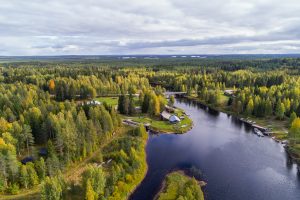
Koitajoki area is a many-sided complex of waterways and wetlands consisting of lakes, meandering parts of river and extensive lowland mires. Its unique nature also includes rare flood meadows used in the former times for cattle grazing as well as extensive and rare mire ecosystems next to the river in the centre of Koitajoki. In the northern part of the river, old growth forests depict the river landscape. Several nature reserves are also located along the river system. It flows next to “Kesonsuo Nature Reserve”, a famous mire formation and bird sanctuary for both breeders and migrants. Also “Petkeljärvi National Park” is easy to reach via Koitajoki river. Petkeljärvi NP is home to old-growth forests including 150 year old shield bark covered pines have remained untouched by the forest industry.
Being a natural connector between various parts of the municipality, Koitajoki has facilitated moving around as part of forestry logs have been floated along the river. Remote Möhkö village used to be an important producer of lake-ore iron and employed over 1000 workers. The iron ore to the ironworks and wood for processing the ore were transported along the river. Other key cultural heritage features of the area are Parppeinvaara rune singers’ village at the centre of the municipality, and Mekrijärvi and Huhus villages that have been important for the collection of Kanteletar; ancient songs and hymns of the Finnish People. River seining of whitefish is also a special, ancient form of fishing still maintained at Koitajoki River.
Role of Koitajoki river in SLOW triathlon development
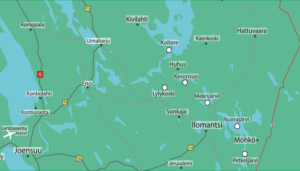
Our initiative, a slow triathlon concept termed “Koitajoki Nature Triathlon” was borne from the idea of merging the nature and cultural heritage along river Koitajoki. The aim being to enhance visitor experiences by connecting the versatile nature and culture values of this unique area with the many-sided visitor services based on slowness and relaxation, moving with muscle power (e.g. kayaking, hiking, canoeing), eating tasty Karelian food, and resting in the local guesthouses. This required developing forest and waterway routes along and across Koitajoki river basin that is centrally located and connects the key tourism regions across the biosphere reserve.
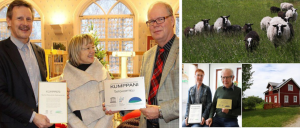
The idea was that the routes would link the already available yet rather fragmented nature and cultural assets into packaged services offered through networking of the region’s service providers. The regions marked in white show how key areas align along Koitajoki River. In order to attain the goal and continue actions post SHAPE project, engaging with regional service providers was crucial. Ilomantsi tourism association with its members (tens of small enterprises) and local associations have been key actors developing the non-destructive tourism uses of the river and other nature objects, and maintaining many typical, local cultural features in cooperation with SHAPE partners and North Karelia BR. Several of the members already belong to North Karelia biosphere reserve network of sustainability partnerships, meaning they too are committed to improving eco-efficiency in their day-to-day activities. Partnership certificates and logos given to partners committed to improving sustainable actions can be used at own premises and websites to increase visibility of sustainable actions.
Development process
Stakeholder engagement and participations have been key throughout the development of Koitajoki Nature Triathlon (KNT). The first two workshops gathered 22 participants consisting representatives from the regional tourism association, tourism entrepreneurs, regional government representatives, educational institute representatives, and a representative from “Metsähallitus” that is responsible for development and management of state-owned land; including support services for tourism activities such as route maintenance.
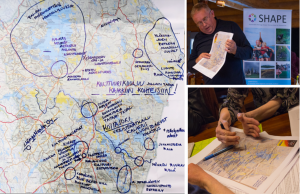
During the workshop, participants were placed into 6 groups within which they mapped assets considered of value, and those that could, if developed, enhance tourism in the region. All groups had a chance to present their mapping exercise, with discussions and comments across the presentations. The opportunities and gaps in developing tourism, as well as potential solutions to challenges were discussed. Participants also mapped their location and services, and existing partnerships.
SHAPE partners analysed the key assets mapped during the first workshop, stakeholder networks from second workshop as a way of identifying existing and potential stakeholder partnerships, as well as strengths and locations of tourism service providers to bridge gaps (challenges and threats) mapped during both workshops.
A heritage and infrastructure map based on the outcomes was thereafter produced. Analysis of the region’s assets in line with Climate Change (CC) projections was also carried out to map potential impacts of Climate Change on the mapped assets and various development ideas from the stakeholders. These results formed the basis of discussions during the third workshop and gave a wider picture of issues to consider when thinking about the choice of the initiative to focus on.
During the third workshop, based on previous workshop outcomes and SHAPE findings, stakeholders came into a mutual agreement that the nature and cultural assets were regional strengths, and that Ilomantsi possesses unique history, quality products and range of services. Still region’s tourism was facing challenges. For example, most dominant were day visitors either passing through to other cities/towns, or attending an event, with overnight stays a maximum 1-2 nights. Infrastructure, route maintenance, public transport, short season and youth migration were key challenges stated as affecting tourism development in the region.
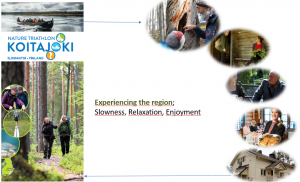
Climate Change related impacts were also considered a threat to developing tourism in the region. At the same time, networking among the service providers was quite weak. From the heritage map showing how mapped assets and locations of service providers were aligned within the Koitajoki river, it became clear that a link between the nature and cultural assets in the region, and networking by service providers was an untapped potential. This is how the “Koitajoki initiative” was borne with aims being to:
- Develop routes along the Koitajoki river that could be offered as tourism product for different segments of tourists.
- Link the region’s natural and cultural assets to the routes
- Encourage networking among Product and service providers (PSPs) through package service development for visitors coming to the region.
The rest of the initiative development workshops 5.2018-11.2019 (6 in total) gathered an average of 15 stakeholders per workshop. The aim was that the stakeholders would themselves have ownership of the initiative in order to enable the continuation post SHAPE, while SHAPE project partners would offer support throughout the development process.
Learning journeys and cooperation with other projects in development of KNT
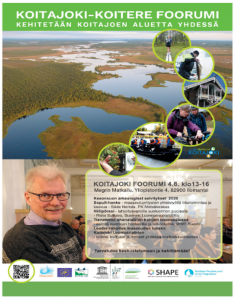
During the development process, stakeholders were given a chance to take part in the SHAPE learning journeys. The learning journey participants were organised keeping in mind their expertise in line with themes of the journeys and bringing back new perspectives that we could incorporate in our initiative. We were lucky enough to have stakeholders with expertise in various fields of tourism who shared the experiences and new viewpoints that could be incorporated in our initiative.
SHAPE also cooperated with other regional projects that had complementary role to the KNT initiative. For example, “Freshabit life IP project” aims at preserving water heritage, the objective being to improve the ecological status and biodiversity of water bodies including also the Koitajoki river. We cooperated with FRESHBIT project on mapping of nature and cultural values by regional stakeholders through a maptionnaire application. PUHTI project collaborated with us in organizing a rental facility that was considered an additional value to KNT.
We shared our findings and collaborated with CBC SUPER project on potential areas for installation of information boards that would guide visitors on waste management practices as part of good practices under KNT. There is also ongoing collaboration with CBC NatureBeST project that seeks barriers of eco-efficiency in accommodation facilities as a way of addressing enterprises’ challenges that may impact ecological status of environments key to maintaining quality of activities such as those intended for KNT.
Visitor values
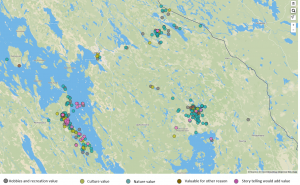
SHAPE survey of visitors helped verify and understand the opportunities and challenges that arouse during workshops. It also acted as a starting point in understanding consumer behaviours of the segment already visiting North Karelia, such as their values and needs; and their potential as a segment for KNT. For example, the most important aspects to visitors when considering and deciding the destination, and strengths of North Karelia Biosphere Reserve as a destination were sought from visitors to the area. Scenic/beautiful landscapes, unspoilt nature, the overall cleanliness of destination and diversity of nature attractions (e.g. national parks, nature activities offered), and environmental actions of product or service providers were considered regional strengths.
On the other hand, it was evident that the average length of nights spent in the biosphere reserve region were predominantly short with approximately 70 percent as day or 1-2 overnight stay visits. When asked how the very aspects of importance were fulfilled while at destination, all mentioned above were met except for easy accessibility to destination, and ease of transportation to and from different targets which were key challenges. Respondents also wanted to see visible the good company practices while planning travel. These needs were taken into consideration during development of KNT. More wider research e.g. of visitors across whole country is still needed.
Climate Change consideration in the development of Koitajoki NT
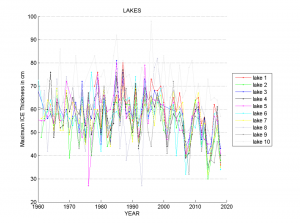
Improving eco-efficiency means that services replace products to a greater or lesser degree, solve customer needs and thus reduce the material and energy needed to perform an economic activity. This means using small material and energy inputs to produce a service. Our initiative aimed at optimizing already existing tourist systems over increasing tourist amount. It is hoped that through the development of packaged services, the initiative will address the short one to two night stays in the region by attracting longer overnights stays in the province; meaning more spending per tourist and lesser environmental impacts. Longer overnight stays are eco-friendly. This would be achieved by improving regional networking among the service providers. An idea of a joint rental facility for equipment would not only decrease burden of service providers, but also act as a way of curbing environmental impacts. Joint rental facility, or outsourcing services like transportation instead of owning everything would reduce the amount of energy and natural resources use. The concept of a “slow triathlon” would maximize moving with muscle power for activities e.g. kayaking, hiking, and canoeing. The biosphere reserve partnership and networking is also a way of encouraging self-regulation among the service providers such that they try to maximize eco-efficiency in addition to providing the visitor experiences.
Lessons learnt

SHAPE Project has helped create and strengthen regional networking of tourism service providers in Ilomantsi region. The actions developed through the project period will continue post project. Its success, if takes place as hoped, will be measurable in near future. Even though infrastructural problems are still in the development stages, new ways of doing things and dealing with uncertainties has been achieved through networking and cooperation during the project period and the testing of the package gathered positive feedback. Involving key stakeholders and making them feel ownership of the project and process has been very important in continuing activities post-project.
Ilomantsi tourism association with its members (tens of small enterprises) and local associations have been key actors in developing the non-destructive tourism uses of the river and other nature objects and maintaining many typical, local cultural features in cooperation with SHAPE partners and North Karelia BR. Many of the actors belong to North Karelia BR network of sustainability partnerhips.
“The international SHAPE nature and culture tourism project is in its final stages, and now we are bringing together what has been learned so far. Ilomantsi stakeholders have been on study trips to Norway, Iceland and Scotland. In autumn, we hosted 12 stakeholders from Scotland who tested our Koitajoki Nature Triathlon concept. It has proved to work now, though there is still a great deal of untapped potential.” Eero Tuomisto, Ilomantsi Tourism Association
The slow triathlon has gained ground in North Karelia and is now being sold as a package service by various entreprises:
-Visit Ilomantsi –Ilomantsi travel guide 2020 –Aksytammat –Möhkön manta
What is North Karelia Biosphere Reserve?
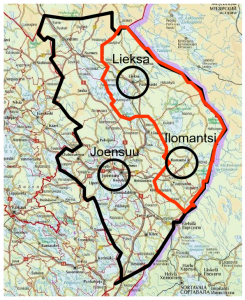
There are more than 700 biosphere reserves in over 120 countries across the globe. There are only two in Finland; North Karelia and Archipelago Sea. North Karelia Biosphere Reserve encompasses an incredibly rich blend of nature. It is home to approx. 2000 lakes let alone the massive stretch of forest covering approx. 70% of the region, which explains why major activities around the region (both commercial and private) rely on or involve nature and natural resources. Magnificent landscapes such as KOLI national Park are also found within the Biosphere Reserve. Koli NP is a national treasure that lies on 2.7 billion years old bedrock – one of the oldest in the world. Besides nature, the BR also consists a distinctive rich Karelian culture solely experienced within the region.
The BR was established in the year 1992 as part of UNESCO Man and Biosphere Programme as a tool to enhance the preservation and development of cultural and natural heritage of its designated area. North Karelia Biosphere Reserve consists – officially – Lieksa city, Ilomantsi municipality, and Joensuu city’s Tuupovaara district. Activities extend across the whole province. The core areas of the biosphere reserve consist protected areas of Koli, Patvinsuo and Petkeljärvi national parks, the Koivunsuo strict nature reserve, as well as Kesonsuo and Ruunaa nature reserves. Even though it includes conservation and protected sites, it does not only consist of protected areas. The area of the Biosphere Reserve that is not protected is called the area of cooperation; it is inhabited and economic activities take place.
North Karelia Biosphere Reserve is home to about 20,000 inhabitants. The aim is that Biosphere Reserve inhabitants live and make a living in balance with their natural environments, and North Karelia Biosphere Reserve role is seek ways to improve that overall relationship between North Karelians and their environment. This is done by promoting the exchange and transfer of ideas and knowledge on sustainability, as well as creating awareness that helps the inhabitants to focus more on sustainable solutions e.g. through projects. All activities are aimed at creating regional sustainable development solutions for better economy and the environment.



